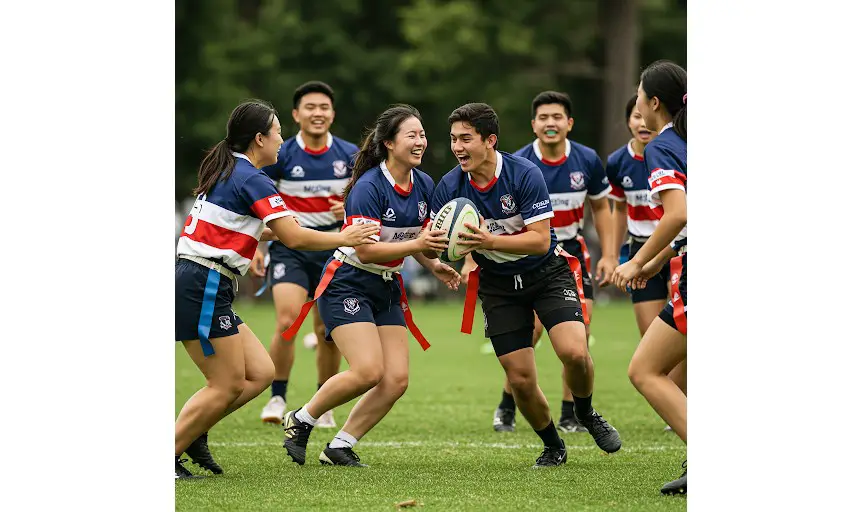
American Flag Rugby: A Thriving Sport Bridging Youth, Culture, and Competition
American Flag Rugby is a fast-paced, non-contact version of traditional rugby. It emphasizes teamwork, strategy, and inclusiveness. The sport originated in the United States but has grown globally. Schools, youth programs, and even international leagues now embrace it. As a result, American Flag Rugby continues to gain momentum worldwide.
The Origins and History of American Flag Rugby
Rugby itself began in 1823 at Rugby School in England. However, American Flag Rugby evolved much later. This variant was created to introduce children to rugby without the risk of contact. In the early 1990s, coaches in the U.S. began modifying rugby rules to suit young players.
By 1998, American Flag Rugby became more organized. Rugby clubs and youth sports leagues adopted the model. The goal was to create an entry point to traditional rugby. It achieved this by eliminating tackling and focusing on skill development.
The Rugby New Jersey organization played a key role. They helped standardize rules and promote the game. Their work enabled the sport to grow beyond local communities. Soon, other states such as Pennsylvania, California, and Texas followed suit. They integrated American Flag Rugby into their youth athletic programs.
Growth was also fueled by interest from schools. Teachers found that the sport taught cooperation, fitness, and respect. These values aligned well with educational objectives. By the 2010s, many school districts included it in their physical education curriculum.
Today, American Flag Rugby is recognized as a critical tool for introducing rugby to new generations. Its safety and inclusivity have made it a favorite among parents, teachers, and coaches.
Global Popularity and Reach of American Flag Rugby
Although the sport started in the U.S., international communities quickly took notice. Countries such as Canada, the United Kingdom, and Australia began forming youth flag rugby leagues. These leagues offered children a way to learn the sport before transitioning to tackle rugby.
In Japan, rugby has deep roots, particularly with schools and universities. American Flag Rugby gained popularity there as a preparatory game. It helped younger students learn basic rules and teamwork without physical risk. Japan’s adoption influenced other parts of Asia, including South Korea and Singapore.
South Africa and New Zealand, both known for their rugby culture, also embraced the sport. Coaches there use American Flag Rugby to train children under 10 years old. The goal is to instill core values early, including discipline and communication.
European countries such as France, Ireland, and Italy now include flag rugby in youth programs. Many of these programs are supported by their national rugby unions. They recognize that flag rugby builds foundational skills essential for future elite players.
As a result, global tournaments for youth flag rugby are becoming common. Events in Europe, Asia, and North America showcase international talent. These tournaments also promote cultural exchange and sportsmanship.
Amateur Play: Youth and School Participation
At the amateur level, American Flag Rugby thrives in schools and community leagues. It caters to children aged 5 to 15. Games take place in gymnasiums, fields, and parks. The environment remains fun and educational, with a focus on development rather than winning.
Coaches are often parents or school staff trained in basic rugby principles. They emphasize skill-building, sportsmanship, and fun. Many programs group players by age and skill level to ensure fairness.
School tournaments encourage inter-district cooperation and healthy competition. These events foster friendships and expose children to structured gameplay. In many districts, winning is secondary to participation and learning.
Summer camps also feature American Flag Rugby. These camps attract children looking for engaging physical activity. They combine drills, mini-games, and mentorship.
In addition, after-school programs often include flag rugby in their offerings. This gives students a chance to stay active while learning teamwork. Schools in both urban and rural areas now recognize its value.
Professional Leagues and Global Associations
Though primarily an amateur sport, American Flag Rugby is gaining professional traction. Semi-professional leagues have emerged in the U.S., U.K., and Australia. These leagues offer pathways for athletes to transition into full-contact rugby or pursue coaching.
The USA Rugby organization supports flag rugby through regional development centers. These centers host clinics, tournaments, and coaching seminars. Similarly, Rugby Canada has embraced flag rugby as part of its youth development initiative.
In the United Kingdom, Rugby Football Union (RFU) promotes tag and flag rugby in schools. Their aim is to expand the sport’s reach and identify talent early. Professional clubs often scout players from these programs.
Australia’s rugby unions also recognize flag rugby’s value. They fund school-based programs and collaborate with community organizations. This effort helps maintain rugby’s popularity across diverse age groups.
While no global professional league exists yet for American Flag Rugby, conversations are ongoing. International rugby federations are exploring the potential of a world flag rugby series. This could become a reality as interest continues to surge.
Political and Social Significance of the Sport
American Flag Rugby holds political and social value beyond the playing field. In many countries, it supports public health initiatives. Governments use it to combat childhood obesity and promote active lifestyles.
The sport also encourages social inclusion. Children of different abilities, backgrounds, and genders can participate equally. This inclusiveness supports educational equity and community cohesion.
Moreover, American Flag Rugby aligns with international goals. Organizations like UNICEF and WHO endorse sports that promote well-being and development. Flag rugby’s emphasis on respect and teamwork reflects these ideals.
In politically divided regions, the sport fosters unity. Joint leagues in areas such as Northern Ireland and the Middle East bring youth together. They focus on shared goals rather than differences.
Local governments often fund flag rugby initiatives. They view it as a low-cost, high-impact program. Schools, parks departments, and non-profits all partner to deliver these programs.
Gender equality is another key benefit. Girls’ participation in American Flag Rugby is growing. Mixed-gender teams are common, and leadership roles are encouraged for all.
By breaking down social and political barriers, the sport builds stronger, more connected communities.
Rules of American Flag Rugby
The rules of American Flag Rugby are simple and kid-friendly. Two teams of five to seven players compete. Each player wears a belt with two flags attached by Velcro.
The game begins with a kickoff or a pass. The attacking team tries to advance the ball by passing and running. Unlike tackle rugby, players must remove a flag to stop progress.
When a flag is pulled, the play stops. The player returns the flag to its owner, who must then pass the ball within three seconds. This rule keeps the game fast and fluid.
Forward passes are not allowed. All passes must go sideways or backward. This encourages teamwork and spatial awareness.
Scoring happens when a player crosses the opponent’s goal line with the ball. Each try earns one point. Games typically last 20 to 40 minutes, divided into halves.
Contact of any kind is discouraged. Blocking, diving, and intentional physical contact result in penalties. Referees enforce rules strictly to maintain safety and fairness.
Players rotate positions to ensure balanced development. Everyone gets a chance to run, pass, and defend. This approach builds well-rounded athletes.
Substitutions are unlimited. Coaches use this to give all players ample playtime. It also keeps energy levels high and engagement strong.
Referees often double as coaches. They explain rules during the game to reinforce learning. This dual role supports a positive experience for young players.
The Future of American Flag Rugby
Looking ahead, American Flag Rugby is poised for continued growth. Its accessibility and safety make it ideal for schools and communities. More nations are adopting it as a stepping stone to traditional rugby.
Technological advancements could enhance coaching and gameplay. Tools such as video analysis and digital playbooks are becoming available. These tools help players improve their skills and understanding.
Colleges and universities may soon offer scholarships for flag rugby. Some already include it in intramural programs. This institutional support will elevate the sport’s profile.
Major sporting events could include American Flag Rugby in the future. International tournaments will draw attention and investment. As a result, professional pathways will become clearer.
Parents, educators, and policymakers continue to support the sport. They recognize its role in building character, fitness, and community.
In conclusion, American Flag Rugby is more than just a game. It is a dynamic tool for education, inclusion, and athletic development. As the sport expands, its impact will grow even stronger.





